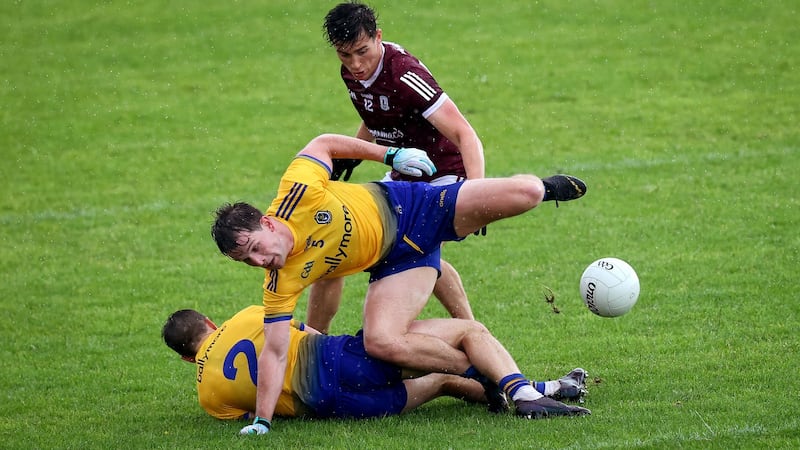It was no fault of the teams but there was something terribly dismal about the spectacle in Hyde Park on Sunday and as the game went on the elephant in the room grew bigger and bigger. There is no escaping this. The All-Ireland football championship is broken.
The big tradition of a gala championship is an illusion. There may be brilliant games coming down the tracks featuring the standard bearers. But that changes nothing. It is supposed to be a national contest. But it is not.
What we saw in Hyde Park was an example of two teams desperately trying to break through to the next level of championship competitiveness. Roscommon are in retreat. Galway are primed.
A few weeks ago, I began arguing that the manner of Galway’s relegation against Monaghan was fake news, essentially. They were careless and got caught and it cost them a hard-earned seat in Division 1. A similar scenario faced them at the second water break in Hyde Park on Sunday. It would have taken an element of self-destruction to lose the game.
That was not going to happen. Crucially, they denied Roscommon any clear goal chance - the received wisdom in these championship games is that Roscommon need goals if they are to win. After Galway’s searing league-opening experience against Kerry, this was a marked improvement.
And I imagine that Roscommon will be frothing at the concession of those goals given their defensive structure. I watched the scores back on slow-mo. I always get nervous when I see a forward on deep-tracking defensive duty. It was that scenario which allowed Galway's Peter Cooke to drift in behind the last line. And it was, shall we say, courteous and gentlemanly defending which gave Mattie Tierney a second bite at his decisive goal late in the day.
Anthony Cunningham came in for some criticism for his defensive shape. But I honestly feel a lot of people don't understand the trade that managers make in these set-ups. The players must have agreed that this tactic offered the best chance of a victory. Once that is agreed, you can't have any conscientious objectors. It is one-in, all in.
And at some point the principle of ambition and the principle of safety overlap. So imagine Roscommon coming in here and they are adamant that they can’t get off to a bad start or ship a big defeat. They don’t have the physical strength to transition into attack as many of the top teams do. They walk a very fine line between not falling away in the match and actually winning the contest.
Their week would have been spent planning defensive match-ups and tracking and so on. And the argument is that the five point defeat was their smallest loss of this season. The counter point is: this is the championship.
You get one day out. Surely you have to have a cut? Don’t die wondering. I was a little surprised by their set up given they have beaten Galway twice in recent championships. I don’t think fear of Galway was an issue.
But internal confidence might have been. And when confidence is low, defenders want extra defensive cover. The conversation becomes about dropping more men back. And straight away you are compromising what you can do on the attacking end of the field. In the last quarter Roscommon were four points down and had players spread across their own defensive 45. And it is too late then to switch into an attacking game.
You are practically pre-programmed to stick with the plan. They finished with 12 scores. That won’t worry any other team.
Tracking defenders is not the natural game of players like Donie Smith or Diarmuid Murtagh. It is taxing. By the time the last water break comes some of best players will be on bench. As it turned out, the Roscommon fullback line scored more from play than the vaunted full forward line - as did Enda Smith from midfield. There is the trade in microcosm. But while Anthony was criticised, so were we when we decided to go a different route during my time in charge of the county.

That said, it was apparent that Galway have three or four top, top players and are at a more advanced stage of physical development. They clearly have the greater potential. Now, they are at the cutting edge and they need the three weeks before the final to try and get Shane Walsh as close to full fitness as possible.
Padraic Joyce will know he needs a more cohesive defensive unit, a big improvement on both their own and opposition kick outs and he needs to get more out of Damien Comer, who is coming back after two years of injury problems.
Galway's younger cohort, led by Matthew Tierney, was the difference between Galway winning and losing here. They supplied 2-6 between them.
But the psychology is perfect because they know they can compete with Mayo and have room for improvement. They see themselves as credible last four contenders now. They are ready for the next level.
Theme
So Roscommon made a disappointing exit, deepening a theme of the summer. Dublin, Mayo, Kerry, Tyrone and Donegal are at the next level - in that order. Then, there is another big group of eleven counties- Galway, Monaghan, Kildare, Armagh, Cork, Meath, Tipperary, Down, Derry, Clare and Roscommon - all caught in a sort of holding pattern. It is hard to categorise them. The want-to-bes or might-bes. In order to break through that glass ceiling and join the top five, you must be a regular Division 1 team. You must be the dominant team in your province.
I looked at the All-Ireland semi-final series from 2011-2020. Dublin featured in all 10 summers, Mayo in nine, Kerry seven, Tyrone five, Donegal three - and an honourable mention for Tipp who got there twice. That, over the course of a decade, is the next level.
It becomes a predictable shuffle. A team goes forward for a few years and then slips back dramatically
Appearing in the last four regularly and bossing your province. That was the ambition I had for us in Roscommon. There are so many counties like Roscommon. I met them regularly in Division 2 and the lower tiers of Division 1. It was a discussion we often had. Can we become consistent enough to get to the next level? And we couldn’t do that.
The best we could do was win a Connacht title and then get a draw with Mayo in an All-Ireland quarter final. Now, Roscommon have not played in an All-Ireland semi-final in 30 years. 1991. It is a long time ago. And they haven’t got a result in Croke Park in 40 years.
Monaghan have been the most consistent of the middle-tier group. Yet they have made it to just one All-Ireland semi-final. It is a poor return from the collective.
So there is a clear gap that all these teams are trying to bridge. Right now, Galway look best placed, with Armagh also looking very promising. But it is not happening for most counties and there is little sign of it happening.
I feel this is the biggest challenge facing the GAA. If they could fix this and get those 10 or 11 teams competing properly then we would have a full hearted, unpredictable All-Ireland football championship, with 16 teams capable of competing with one another and producing shock results.
This is a deep rooted issue and it is really sucking the life out of squads throughout the land. Management, players, supporters and the county boards are finding it increasingly hard to even touch that dream - summer days in Croke Park, giddiness in the county, flags out. Those are becoming rare sights - everywhere.
Galway have grabbed hold of this possibility and I think their potential is predicated on the five young lads that Galway brought through. In 2017 Roscommon won the Under-17 Connacht final against their team. Three years later they were annihilated in the Under-20 final. And Galway got those five central players - the Kelly brothers, Tierney, Sean Mulkerrin and Dylan McHugh from that group. Roscommon had zero players on the match day 26 on Sunday.
What happened there? The solution is crying out: development structures need to be put in place in every county. The blueprint may be there - it is called Dublin GAA. But the organisation must embrace the spirit of equity and equality.
Opportunity
Some inequalities are natural - population and work and educational opportunities. Most of the Roscommon senior players do not live in the county. So potential coaches - the ex players - often aren’t there. That matters and increases the challenge. These are natural inequalities. They can’t really be helped.
I am not sure crowds will come back in the numbers we take for granted. Why go to watch Leitrim or Sligo or Roscommon get pulverized by Galway and Mayo over the next few years?
But strength and conditioning can be controlled on a national level. That inequality is leading to a slaughter of the innocents. Watch Mayo-Leitrim, if you dare, for an example of this next week. This stuff is smashing the morale of really proud GAA counties who are lost in a spiral.
Roscommon have had two championship games in two years and lost both. What does that do for the best group the county has produced since 1990? There is no new wave coming up behind them because the underage development has not been at a level to allow for that.
So it becomes a predictable shuffle. A team goes forward for a few years and then slips back dramatically.
I don’t see things changing when the pandemic has passed because by then morale will be shot. Roscommon made a huge effort to make it to that next level but they are back at square one now.
I am not sure that crowds will come back in the numbers we take for granted. Why go to watch Leitrim or Sligo or Roscommon get pulverized by Galway and Mayo over the next few years? These teams and counties are lost: they are out of solutions.
If the GAA doesn’t step in then we will have two or three counties dominating and the vast majority in retreat. Many counties will look at the cost of participation in terms of finance and time and figure it is not worth it.
The top teams are like a runaway train. Galway and maybe one or two others might catch it. But don’t pretend that makes an All-Ireland championship.















